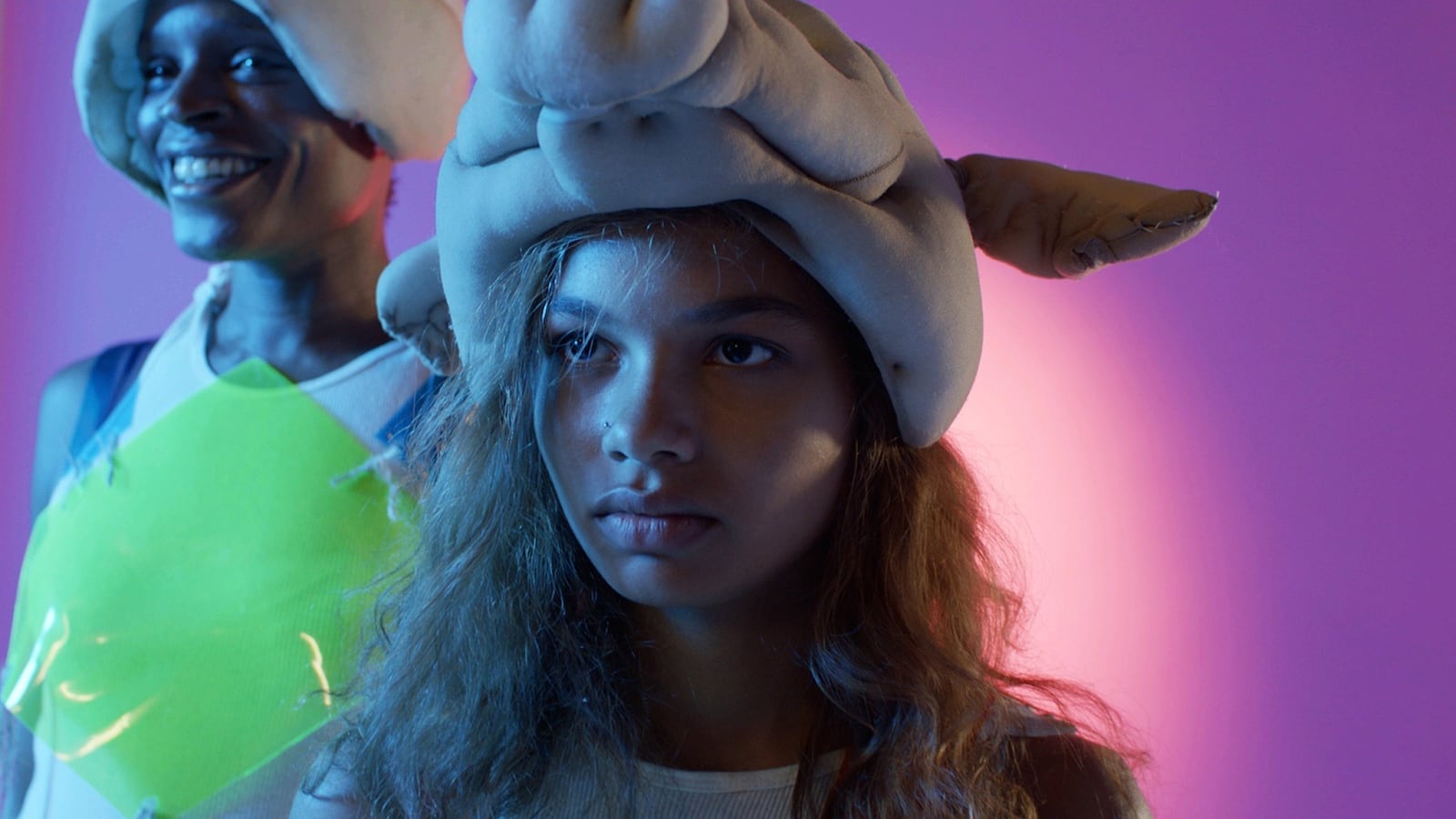Several minutes into her twice-eponymous film, Madeline (Helena Howard), cocooned in an elaborate turtle costume, waddles along the beach. She rushes toward the breaking waves as the camera jerks behind. “Madeline, what are you doing?” a voice chides.
Suddenly we’re inside an empty theater. Madeline lies prostrate on a bare stage, breast-stroking the air in a green sweater. “You were a sea turtle and then you were a woman playing a sea turtle,” instructs Evangeline (Molly Parker), Madeline’s experimental theater troupe director. She clasps Madeline’s hands. “Whose hands are those? Are they yours, or are they the turtle’s?”
In Madeline’s Madeline, there’s a loopy line between the real and the imagined. Chaos is the movie’s baseline, with fractured images and sounds that bleed and blur and quake, so unstable as to feel radioactive. Ordinary exchanges erupt into abstract colors; scenes drag out or last just a few moments. The movie’s one constant is Madeline, a temperamental teenager and aspiring stage actor who appears in nearly every frame. We get to know her image well: stormy eyes, lanky limbs, sly smile. It’s ironic that she becomes our visual anchor when she can’t find stable ground herself.
Madeline lives with her mother Regina (Miranda July), a skittish woman who surveils her daughter’s erratic moods with a mixture of dread and wonder. When Madeline hops on the kitchen table purring like a cat, Regina plays along, stroking Madeline’s head and murmuring, “good kitty.” In other moments, her attempts to stabilize Madeline go too far or backfire. When Madeline tells Regina about her first kiss with a boy she likes, Regina frets about herpes and self-protection. And when she catches Madeline watching porn with neighborhood boys, she loses it completely.
Theater class provides Madeline’s only escape from her family dysfunction, and Evangeline, who is pregnant with her first child, grows into a kind of solicitous surrogate mother to her. But after Madeline confides in Evangeline about a dream (a repressed wish, per Freud) in which she struck her mother with a hot iron, things take a turn. Coaxed by Evangeline, the troupe begins to transmute the mother-daughter relationship into fodder for the immersive theater show they’re developing. Play-acting the breakdown onstage, Madeline becomes the troupe’s star. But boundaries are being crossed and rewritten. Is Madeline a sea turtle or a woman performing? Is her murderous rage against her mother genuine or just pretend?
In many ways, Evangeline is a dramatized stand-in for Josephine Decker, the film’s writer-director. The seed of the film was planted when Decker discovered Howard—who had never been in a movie before Madeline’s Madeline—at a teen arts festival; Howard performed a monologue from the somber stage drama Blackbird that left Decker in awe.
“It was clear that she had a lot of access to her emotions, and she was able to be very, very vulnerable,” Decker says on a sunny Monday in Brooklyn several weeks before the film’s release. “I think actors are kind of like the new gods. At times that seems ridiculous, but I think the ones who are worth worshipping—they are almost gods. They’re accessing all of humanity in their career as actors, and doing that is powerful. You’re kind of meeting the spirit world. I felt like she could do that, so I wanted to be closer to that and do a work that would showcase that.”
Decker’s third feature after two smaller but equally mesmerizing indies, Madeline’s Madeline is the juicy fruit of an entirely collaborative effort: hours of improv workshops, debates, and analysis among Decker, Howard, and the ten actors who form Howard’s troupe in the movie. Through the workshops, Decker says, “The troupe itself became a character—kind of one organism that was speaking with this collective mind about their frustrations with the process.”
Together, the team baked their difficulties and discontents into the film’s script. The result is an immersive piece of meta-art that transcends conventional narrative boundaries and probes the ethics of collaboration, authority, and ownership. In the film, Evangeline ignores the troupe’s grievances as her laser-focus on achieving her creative vision veers into megalomania. Decker spent the duration of her project agonizing that she was doing the same.
“It was my deep fear: of not being aware of what was going on in the room, not checking in with people about their experience, letting the project come before the people,” says Decker. “That’s not to say that I got it right. I think that I fucked up a lot of those throughout the process, which ended up being why I wanted to put them in the movie. Nobody talks about these subtle exploitations.”
She adds, “Is there a line in regards to exploitation? I think the line is different for every project and every relationship. But it should be defined by very deeply encountering the people you’re working with, and identifying potential holes in the process, and trying to clarify your own intentions—or maybe lack of knowledge about what you’re doing.”
The film is such an exceptional invention—fluid and delirious, with each scene resembling a dream or a foggy memory—that it feels almost sacrilegious to address it on the same terms as a coherent, linear narrative. Structurally, the film is more akin to a complicated piece of orchestral music. As with melodies in a song, themes and cryptic motifs will arise, vanish, reappear. During production, Decker says, she listened to George Gershwin’s Rhapsody in Blue “like forty times in a row.” To Decker, the composition “is amazing because it sets up one set of themes at the beginning and then just plays with them again and again throughout. You feel when a theme needs to come back, or when you want to delay, delay, delay.”

In Decker’s film, mental illness provides one of the most central themes. Murmurs of pills and past hospitalizations occur throughout, and we watch Madeline ride out moody dips and manic peaks. We’re never sure what exactly she suffers from, but imposing any type of diagnosis seems counterintuitive. Though her troubles extend beyond the gamut of normal teenage angst, they’re too distinctive and interlaced in the movie’s unique form to get bogged down with particulars.
One reading of the film’s unruly style and structure is that they’re meant to echo Madeline’s experience of the world—as if the film were a lens through which we can weather the waves of life as Madeline does. But the film is more than an immersive portrayal of psychosis; to take it that way is to ignore the very specific voice of its director, which reverberates through the film with lyrical gusto.
“I love that the film can be read in multiple ways,” Decker says. “If I want to have the audience have an experience where they’re making up their own minds about meaning or what really happened, I have to also be asking that question. If I’ve answered it for myself, the audience is going to feel that and they’ll all come to that conclusion. So I tried to not answer all those questions—how much is in her mind, how much is in reality—to leave it pretty open.”
True to her intention, the story of Madeline’s Madeline can be taken as real or illusory, or some combination of the two. It can also be accepted as inscrutable. Mostly, it is engrossing and transcendent, and it’s the closest a movie has ever come to unlocking the spirit of immersive theater.
By the end, when Madeline does begin to squirm free of Evangeline’s toxic grip, it doesn’t represent a restoration of Madeline’s safety or sanity; rather, it’s just another step in her windy route to self-realization. No matter what, Madeline won’t be Evangeline’s or Regina’s or even Decker’s. Like a truly visionary artist, she doesn’t belong to anyone but herself.






